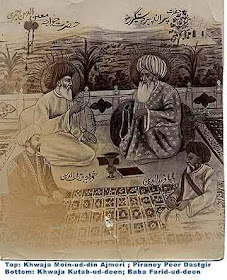


The Shrine of founder of Sufism in Indian Subcontinent, the eminent 11th century Persian Sufi master,



The Shrine of founder of 12th century 'Chisti Sufi Order' in India, Moinuddin Chisti.

Gathering of Sufis in India, 11th century miniature

Gathering of Sufis in India, 17th century miniature
Sufi Movement in Medieval India
Shah Wali Ullah divides Sufism into four epochs, though the four historical epochs were not mutually exclusive. There was considerable overlap. The first epoch began with the prophet and his companions and extended until the time of Junaid of Baghdad. According to Yusuf Husain, the Sufis of the first two centuries of Hijrah were ascetics, who laid great stress on the principles of Tauba and Tawakkul. Their contemplation remained confined within the limits of the Quran and the practice of the prophet.
The second epoch started during Junaid’s time. The Sufis of this period lived in a state of continued meditation and contemplation. This resulted in intuitive insights and intense spiritual experiences that could be expressed only symbolically or in unusual phrases. They were so emotionally affected by “sama’” that they swooned or tore their clothes in ecstasy. In this period the Sufis were better organized and were divided into sects. Sufi masters now began to send their disciples to distant lands. Many eminent Sufis also moved to India.
The third epoch started from the advent of Shaikh Abu Said Ibn Abdul Khair and Shaikh Abul Hasan Kharaqani. The Sufis of the period live in a state of ecstasy, which led to “Tawajjuh” (spiritual telepathy). In contemplating the union of temporal and eternal their individuality dissolved, and they even ignored their regular religious practices.
The fourth began with the birth of Shaikh Akbar Muhiyuddin Ibn al-‘Arabi (1165-1240 AD), when the Sufis discovered the theory of the five stages of the descent from “Wajibul Wujud” (Necessary Being), i.e. Ahadiyya (Essence of Primal One), Wahdaniyya (Unity of God), sphere of Arwah (sphere of Infinite Forms), sphere of Misal (Similitude or Angelic Forms), sphere of Ajsam (Bodies of Physical World).
Before reaching India, the movement of Tasawwuf had reached the highest point of its development in the twelfth century. After the conquest of northern India by the Muslims, various Sufi orders were established, in particular, the Chisti and Suhrawardiyya orders. The orders of Qadiri, Naqshabandi, Shuttari, Madari ect, also represented and functioned on more or less the same lines. The Sufi who left an indelible mark both on India and on the history of Sufism was Abul Hasan Ali Ibn Usman al-Hujwiri, known as Data Ganj Bakhsh, who reached Lahore in 1035 AD. He wrote Kashful Mahjub in Persian, contains biographies, thought and practices of Sufis from the prophet Muhammad’s day to his own time.
The order of the Chistis, founded by Khawaja Abdal Chisti (d. 966 AD), was introduced into India by Khawaja Muinuddin Chisti. He was born in Sistan in 1143 AD. He traveled widely in Islamic countries and came to Harun, a town in Nishapur, and became the disciple of Khawaja Usman Haruni, a famous saint of the Chisti order, who directed him to settle in India. Khawaja Muinuddin arrived in India in 1190 AD. , And first proceeded to Lahore, where he spent some times in meditation at the tomb of Ali Hujwiri. The surviving sayings of the Khawaja show that his life’s mission was to inculcate piety, humility, and devotion to God.
The Chisti mystics believed in the spiritual value of music and patronized professional singers, whatever their caste or religion might be. Khawaja Qutbuddin Bakhtiar Kaki, the successor of Muinuddin died in a state of ecstasy while listening to music.
Another Khawaja Muinuddin’s disciple, Shaikh Hamiduddin made Nagaur (Rajasthan) the chief Chistiyya order. He was then succeeded by his grandson Fariduddin Mahmud. One of Shaikh Farid’s disciples, Khawaja Ziyauddin Nakhshabi was a famous scholar who translated Chintamani Bhatta’s Suka-Saptati into Persian from Sanskrit and gave the title Tuti Nama.
Of the Khawaja Muinuddin’s disciples, Shaikh Fariduddin Ganjshakar or Baba Farid was very celebrated. He settled in Ajodhan and built his Jamaat Khana. Baba’s successor was Shaikh Nizamuddin Auliya (1238-1325 AD), who came from Badaun but had settled in Delhi. Under Khawaja Nizamuddin, Chistiyya order became the dominant Sufi silsila in India. The collection of his conversation known as “Fawaid al-Fuad” compiled by his disciple, Amir Hasan. From him began the Chistiyya Nizamiyya, while Alauddin Sabir of Kalyar, another disciple of Baba Farid, led Chistiyya Sabiriyya.
Nizamuddin, known also as Mehboob Ilahi, stressed on the motive of love, which leads to the realization of God. He extended his love of God to the love of humanity without which the former would be incomplete. After Nizamuddin, some Chisti saints became the successors one after the other. They are Nasiruddin Chiragh Dahlavi, his malfuzat known as “Khairul Majalis”, Sayyid Muhammad Gesudaraz, who wrote “Khatairu al-Quds”, “Asma al-Asrar”, “Sharh Risala-e-Qushairi”, ect. Gesudaraz earlier works are based on Wahdatu al-Wujud, but was later converted to Wahdat al-Shuhud doctrines.
After the death of Shaikh Ruknuddin the Suhrawardiyya silsila declined in Multan but became popular in other provinces like Uch, Gujarat, Punjab, Kashmir and even Delhi. It was revitalized by Sayyid Jalaluddin Bukhari known as Makhdum Jahaniyan, the world traveler. He was puritan and strongly objected the Hindu influences to Muslim social and religious practices.
Another contemporary mystic who is worthy of mention was Shaikh Sharfuddin Yahya Manairi (d. 1380 AD). He belonged to the Firdausia order, a branch of Suhrawardiyya. He compiled several books, i.e. “Fawaid al-Muridin”, “Irshadat al-Talibin”,”Rahat al-Qulub”, ect.
Qadiri order was founded by Shaikh Abdul Qadir Gilani of Baghdad (d. 1166 AD). The first who introduced it to India was Sayyid Muhammad Gilani Qodiri of Aleppo, who later settled in Uch where he died in 1517 AD. Other famous mystics of Qadiri order were and Shaikh Abdul Ma’ali of Lahore. Shaikh Abdul Haq Muahddis Dahlawi wrote many important books one of them was “Akhbar al-Akhyar”. Dara Shukoh, the son of Shah Jahan was a devotee of Qadiri order. He wrote “Safinat al-Awliya” and “Sakinat al-Awliya” on the mystics biographies.
Naqshabandi order seems to be destined to accept the challenge flung against orthodox Islam in India by the upholders of the doctrine of the “Unity of Being”, and the electicism of Akbar. Naqshabandi order is the offshoot of Khwajagan order. Khwajagan order was founded in Turkistan by Khwaja Ahmad Ata’ Yaswi. The order was popularized by Khwaja Bahauddin Naqshabandi (d. 1388 AD). After him the order was known as Naqshabandi. He emphasized to follow the sunnah. The order was introduced to India by Khwaja Baqi’ Billah (1563-1603 AD) and popularized in India by Shaikh Ahmad Sirhindi (d. 1624 AD), known as Mujaddid Alf Thani. After him the order named Naqshabandiyya Mujaddidiyya.
Rejecting the “Wahdat al-Wujud” (Unity of Being) he expounded the doctrine of “Wahdat al-Shuhud” (Apparantism). Shah Wali Ullah, another mystic of Naqshabandi order tried to compromise both the two doctrines. In his treatise “Faislatul Wahdatul Wujud wa al-Shuhud” he stood as an arbiter on the dispute of both doctrines. But in other occasion he observed in his book “Tafhimat Ilahia”, that “Apparantism” is higher than that of the “Unity of Being”.
_____________________
You might also like these:
The following documents are in PDF
 format.
format.- "The Interpretation of the Classical Sufi Tradition in India: The Shama'il al-atqiya' of Rukn al-Din Kashani."

- "From Hagiography to Martyrology: Conflicting Testimonies to a Sufi Martyr of the Delhi Sultanate."

- "Sufism and Yoga according to Muhammad Ghawth."

- "Situating Sufism and Yoga."

- “Accounts of Yogis in Arabic and Persian Historical and Travel Texts.”

- "Reconfiguring the relation between religion and world: Sufism and reformist Islam in South Asia since the 18th century."










No comments:
Post a Comment